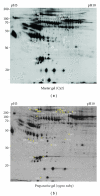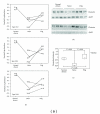Proteomic analysis of sera from common variable immunodeficiency patients undergoing replacement intravenous immunoglobulin therapy
- PMID: 21960740
- PMCID: PMC3180879
- DOI: 10.1155/2011/706746
Proteomic analysis of sera from common variable immunodeficiency patients undergoing replacement intravenous immunoglobulin therapy
Abstract
Common variable immunodeficiency is the most common form of symptomatic primary antibody failure in adults and children. Replacement immunoglobulin is the standard treatment of these patients. By using a differential proteomic approach based on 2D-DIGE, we examined serum samples from normal donors and from matched, naive, and immunoglobulin-treated patients. The results highlighted regulated expression of serum proteins in naive patients. Among the identified proteins, clusterin/ApoJ serum levels were lower in naive patients, compared to normal subjects. This finding was validated in a wider collection of samples from newly enrolled patients. The establishment of a cellular system, based on a human hepatocyte cell line HuH7, allowed to ascertain a potential role in the regulation of CLU gene expression by immunoglobulins.
Figures



Similar articles
-
Gene expression profiling in peripheral blood mononuclear cells of patients with common variable immunodeficiency: modulation of adaptive immune response following intravenous immunoglobulin therapy.PLoS One. 2014 May 15;9(5):e97571. doi: 10.1371/journal.pone.0097571. eCollection 2014. PLoS One. 2014. PMID: 24831519 Free PMC article.
-
[Common variable immunodeficiency in adults and problems of its immunotherapy].Ter Arkh. 1998;70(5):14-20. Ter Arkh. 1998. PMID: 9644735 Russian.
-
Intravenous immunoglobulin replacement prevents severe and lower respiratory tract infections, but not upper respiratory tract and non-respiratory infections in common variable immune deficiency.Allergy. 2005 Mar;60(3):385-90. doi: 10.1111/j.1398-9995.2005.00756.x. Allergy. 2005. PMID: 15679727
-
How I treat common variable immune deficiency.Blood. 2010 Jul 8;116(1):7-15. doi: 10.1182/blood-2010-01-254417. Epub 2010 Mar 23. Blood. 2010. PMID: 20332369 Free PMC article. Review.
-
When to initiate immunoglobulin replacement therapy (IGRT) in antibody deficiency: a practical approach.Clin Exp Immunol. 2017 Jun;188(3):333-341. doi: 10.1111/cei.12915. Epub 2017 Jan 30. Clin Exp Immunol. 2017. PMID: 28000208 Free PMC article. Review.
Cited by
-
Systemic hyperfibrinolysis after trauma: a pilot study of targeted proteomic analysis of superposed mechanisms in patient plasma.J Trauma Acute Care Surg. 2018 Jun;84(6):929-938. doi: 10.1097/TA.0000000000001878. J Trauma Acute Care Surg. 2018. PMID: 29554044 Free PMC article.
-
Immunosuppressive therapy with rituximab in common variable immunodeficiency.Clin Mol Allergy. 2019 May 6;17:9. doi: 10.1186/s12948-019-0113-3. eCollection 2019. Clin Mol Allergy. 2019. PMID: 31080365 Free PMC article. Review.
References
-
- Rosen FS, Eibl M, Roifman C, et al. Primary immunodeficiency diseases. Clinical and Experimental Immunology, Supplement. 1999;118(1):1–28.
-
- Cunningham-Rundles C, Bodian C. Common variable immunodeficiency: clinical and immunological features of 248 patients. Clinical Immunology. 1999;92(1):34–48. - PubMed
-
- Park MA, Li JT, Hagan JB, Maddox DE, Abraham RS. Common variable immunodeficiency: a new look at an old disease. The Lancet. 2008;372(9637):489–502. - PubMed
-
- Ardeniz O, Başoğlu OK, Günşar F, et al. Clinical and immunological analysis of 23 adult patients with common variable immunodeficiency. Journal of Investigational Allergology and Clinical Immunology. 2010;20(3):222–236. - PubMed
Publication types
MeSH terms
Substances
LinkOut - more resources
Full Text Sources
Research Materials
Miscellaneous
